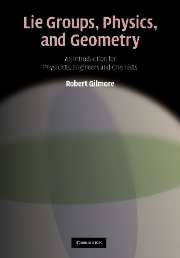Book contents
- Frontmatter
- Contents
- Preface
- 1 Introduction
- 2 Lie groups
- 3 Matrix groups
- 4 Lie algebras
- 5 Matrix algebras
- 6 Operator algebras
- 7 EXPonentiation
- 8 Structure theory for Lie algebras
- 9 Structure theory for simple Lie algebras
- 10 Root spaces and Dynkin diagrams
- 11 Real forms
- 12 Riemannian symmetric spaces
- 13 Contraction
- 14 Hydrogenic atoms
- 15 Maxwell's equations
- 16 Lie groups and differential equations
- Bibliography
- Index
16 - Lie groups and differential equations
Published online by Cambridge University Press: 05 September 2012
- Frontmatter
- Contents
- Preface
- 1 Introduction
- 2 Lie groups
- 3 Matrix groups
- 4 Lie algebras
- 5 Matrix algebras
- 6 Operator algebras
- 7 EXPonentiation
- 8 Structure theory for Lie algebras
- 9 Structure theory for simple Lie algebras
- 10 Root spaces and Dynkin diagrams
- 11 Real forms
- 12 Riemannian symmetric spaces
- 13 Contraction
- 14 Hydrogenic atoms
- 15 Maxwell's equations
- 16 Lie groups and differential equations
- Bibliography
- Index
Summary
Lie group theory was initially developed to facilitate the solution of differential equations. In this guise its many powerful tools and results are not extensively known in the physics community. This chapter is designed as an antidote to this anemia. Lie's methods are an extension of Galois' methods for algebraic equations to the study of differential equations. The extension is in the spirit of Galois' work: the technical details are not similar. The principle observation – Lie's great insight – is that the simple constant that can by added to any indefinite integral of dy/dx = g(x) is in fact an element of a continuous symmetry group – the group that maps solutions of the differential equation into other solutions. This observation was used – exploited – by Lie to develop an algorithm for determining when a differential equation had an invariance group. If such a group exists, then a first order ordinary differential equation can be integrated by quadratures, or the order of a higher order ordinary differential equation can be reduced.
Galois inspired Lie. If the discrete invariance group of an algebraic equation could be exploited to generate algorithms to solve the algebraic equation “by radicals,” might it be possible that the continuous invariance group of a differential equation could be exploited to solve the differential equation “by quadratures”? Lie showed emphatically in 1874 that the answer is YES!, and work has hardly slowed down in the field that he pioneered from that time to the present.
- Type
- Chapter
- Information
- Lie Groups, Physics, and GeometryAn Introduction for Physicists, Engineers and Chemists, pp. 284 - 308Publisher: Cambridge University PressPrint publication year: 2008



